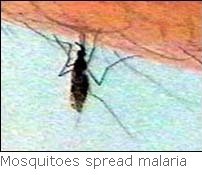North-South Globalization and Action Initiatives:
Multiple News Media in the Emerging Global Communication Space
Francis A. Beer, Political
Science Department, University of Colorado, Boulder CO
G. Robert Boynton, Political Science Department, University of Iowa,
Iowa City IA
Globalization is a central concern
in 21st century global discourse. Elites based in different
global quadrants have diverse positions, not just on the world's physical
surface, but also on its rhetorical plane. Northern elites seem to favor
making globalization a powerful symbol in political thought and action.
Southern elites may have a more mixed stance, with many favoring local
emphases. Among these elites are those at the top of news media.
The news media are major purveyors
of globalization. Globalization becomes present to the citizens of the world
as news media reach out to a global audience. As improving communication
technologies have made real time global communication possible, northern
networks like CNN and BBC have used the technology to develop globally
oriented television news programs. Their offerings, CNN WorldView and
BBC World, attempt to connect with a global audience. The further
development of the web has allowed organizations with considerably less
funding than BBC and CNN to try for a global audience as well. The southern
network Aljazeera, for example, recently supplemented its Arabic
language programming and began to produce a news website in English in an
obvious attempt to extend its global reach.
As global media develop, the use
of common technology, language, and professional norms
can help drive international integration. A
globalizing regime of international communication creates an
emerging common space into which media elites can expand. These new
channels allow them to grow their audience, to bring their product to a
wider market. In order to play on this stage, media actors must adapt
to its globalizing constraints and converge. Common media
technology, language, and norms mean that media actors have only
limited degrees of freedom. At the same time different media actors spring
from distinct roots. Their traditions, cultures, contexts, and agendas
can vary widely. They seek to construct discrete brands, appealing to
particular audiences. This divergence flavors media content, even in a
globalizing age. Globalizing media and localizing differences interact.
Together, they produce a mixed result, combining international
integration and diversity.
Our paper builds on prior research on
globalizing media (Beer and Boynton 2003, 2004; see also Artz and
Kamilipour, 2006). It examines similarities and differences in the
presentation of news by websites aspiring to a global audience in the north
and in the south. We compare the websites of Aljazeera, BBC and CNN. The
central question we ask is what does 'global' come to mean as media from
north and south attempt to reach a global audience? How are the
stories reported similar and dissimilar? Are there greater differences
between southern (Aljazeera) and northern (BBC, CNN) centered global media
than within the class of northern networks (BBC, CNN)? Examining what they
make of globalization illuminates the strains in the contemporary vision of
globalization and portends a future influenced by media construction of
globalization.
Scope and Method
This study is based on a large
collection of the daily news websites of the English language version of
Aljazeera, BBC World, and CNN World. The websites were recorded
approximately six days a week between January 1, 2005 and early November of
2005. They were captured by downloading and saving the home page of the site
and all the pages linked to the home page. The sites were captured at about
midnight central standard time USA, which meant they were what viewers saw
when they looked at the sites first thing in the morning. The sites may
change more than once a day. Any stories that appear and then are taken off
the site between midnight one day and midnight the next day are not included
in the dataset. The entire collection was searched for stories that included
the word "initiative" anywhere in the text; 367 stories were found.
The Coded Language of
North-South
"North-south" is a
major theme of academic international relations theorizing and
research. Generally, the global north is geographically defined
to include states in North America, Northern Asia, and Western
Europe. The global south includes territories at lower
latitudes. Geography, however, is not the only determinant of
north-south identity. The degree of economic development as well as
political, cultural, and historical linkages can also be important. As
a result, China is sometimes included in the global south and
Australia in the north. During the early Cold War years after World War
II, the dominant axis of separation was east-west, dividing the United
States and its western allies from the more easterly Soviet bloc. With
the emergence of detente and the end of the Cold War, the relevance of
east-west differentiation declined, and the north-south axis became
more prominent. International security issues between major powers
like the United States and Russia became less pressing, at least for a
while, and domestic security within such states became more
important . Terrorism replaced the Cold War and the Global War on
Terror replaced replaced deterrence at the top of the issue
agenda. In the context of globalization, political economic concerns of
less privileged nations also received more attention.
Since we are interested in the way
that north-south differences appear in the globalizing news media, it seems
appropriate to begin directly with the key words themselves.
Surprisingly, the language of north-south does not exist in
the language of news media that aspire to a global audience. The
phrase north-south" as well as the separate words "north" and
"south" are present mainly in their absence. They are just not
there -- the count is 0 in the ten months we examined. It is unclear
what we should conclude from the missing key words. At the very least, media
actors do not seem to include "north-south" explicitly in their
professional vocabulary.
At the same time, many issues that
international relations scholars might categorize as north-south do
appear in media stories about "initiatives." News media that
aspire to a global audience present many north-south issues in
terms of initiatives. The language of initiatives is
the language of innovation and action. Initiatives signal that
action is breaking into the ongoing stream of events. Revisionist
actors are attempting to change the status quo. They may, for example,
seek to find a new solution to an ongoing conflict in the Middle East.
Or they may attempt new health programs in particular regions. Initiatives
are news. Something new is happening. Globalizing news media naturally
focus directly on initiatives and indirectly fold north-south themes into
stories about them.
Categories of Initiatives
With these concerns in mind, we coded
the initiatives we found into several major issue categories and counted the
frequencies of each for the three global news websites as described below in
Table 1.
Reports about initiatives in conflict and health appear more often than
other types of reports. Other issues receive lesser coverage. Stories about
economic assistance initiatives are about actions by a nation or
group of nations to aid another nation. Reports about economic
development initiatives are about activities by a country to
improve its own economy.
TABLE 1
GLOBAL MEDIA NETWORKS:
INITIATIVE FREQUENCY BY ISSUE CATEGORY
|
Type of Initiative |
Aljazeera |
BBC World |
CNN World |
|
|
Total |
|
Conflict |
54 |
21 |
15 |
90 |
|
Health |
7 |
32 |
14 |
53 |
|
Local [national] politics |
9 |
15 |
18 |
42 |
|
Economic assistance |
10 |
14 |
12 |
36 |
|
Economic development |
14 |
7 |
10 |
31 |
|
Nuclear proliferation |
12 |
3 |
9 |
24 |
|
Human rights |
12 |
3 |
2 |
17 |
|
Education |
1 |
6 |
9 |
16 |
|
Environment |
3 |
7 |
2 |
12 |
|
Culture |
4 |
3 |
4 |
11 |
|
Corruption |
4 |
3 |
2 |
9 |
|
Elections |
3 |
1 |
5 |
9 |
|
Global institutions |
4 |
0 |
2 |
6 |
|
Diplomacy |
1 |
2 |
1 |
4 |
|
Disasters |
1 |
1 |
2 |
4 |
|
Democracy |
3 |
0 |
0 |
0 |
|
Total |
142 |
118 |
107 |
367 |
The communication convergence hypothesis
suggests that globalizing media will cover different initiative issues in
similar ways. Alternatively, a divergence perspective implies radically
different news reports. Northern globalizing media--BBC World and
CNN World, might be more concerned with east-west issues left over from
the Cold War, nuclear weapons, for example. Southern globalizing media,
represented by Aljazeera, might be more interested in post-colonial
conflicts and development (Slater, 2004). Our results tend to be
mixed. Table 1 shows that Aljazeera does somewhat more
stories on initiatives overall, particularly conflict. Aljazeera also
takes the lead in reporting initiatives on economic development, human
rights, and--contrary to our expectations--nuclear proliferation. At the
same time, BBC does more on economic assistance, the environment, and
health. CNN does more on education, elections, local/national politics.
There is no clear north-south pattern in general issue coverage.
Types of Initiatives
Inside each of these major initiative issue categories, there are different
sub-types of initiatives. Since globalizing media coverage did not reveal
clear north-south dimensions between issues, we decided to examine more
closely media coverage within two separate issue areas: conflict and
health.
Conflict Initiatives
Conflict initiatives include action items for different locations. Table 2
below presents the geographical target of conflict related initiatives. The
Table shows that there is some difference in geographical coverage between
websites. Aljazeera, with its Middle Eastern roots, covers Iraq and
Palestine/Israel the most, though the other two networks also give them some
play. BBC likes Pakistan-India and Darfur, perhaps because of its imperial
heritage. "Global" gets some attention from Aljazeera and CNN. North-south
dimensions again range from mixed to
unclear.
TABLE 2
GLOBAL MEDIA NETWORKS:
CONFLICT ISSUE CATEGORY:
INITIATIVE FREQUENCY BY GEOGRAPHICAL LOCATION
|
Locus |
Aljazeera |
BBC |
CNN |
Totals |
|
Palestine-Israel |
34 |
5 |
9 |
48 |
|
Iraq |
7 |
2 |
0 |
9 |
|
Pakistan-India |
1 |
6 |
0 |
7 |
|
Global |
3 |
0 |
3 |
6 |
|
Darfur |
1 |
3 |
0 |
4 |
|
Africa |
1 |
1 |
1 |
3 |
|
Chechnya |
1 |
1 |
0 |
2 |
|
Afghanistan |
0 |
1 |
0 |
1 |
|
China-EU |
0 |
0 |
1 |
1 |
|
China-Russia |
1 |
0 |
0 |
1 |
|
China-Taiwan |
0 |
1 |
0 |
1 |
|
Cyprus |
1 |
0 |
0 |
1 |
|
Eritrea-Ethiopia |
1 |
0 |
0 |
1 |
|
France-Martinique |
0 |
0 |
1 |
1 |
|
Iran |
1 |
0 |
0 |
1 |
|
North Korea |
0 |
1 |
0 |
1 |
|
Sri Lanka |
1 |
0 |
0 |
1 |
|
Syria |
1 |
0 |
0 |
1 |
|
Totals |
54 |
21 |
15 |
90 |
Health Initiatives
Table 3 presents results for health initiatives, the second most frequent
issue category. Among the networks, BBC seems most interested in health
issues, Aljazeera the least. Malaria and AIDS get somewhat more attention than
other themes. There do not seem to be clear
north-south asymmetries in the coverage of particular diseases.
Interestingly,
though, Aljazeera’ malaria coverage is relatively strong, while a sexually
transmitted disease like AIDS does not exist in Aljazeera
netspace.
TABLE 3
GLOBAL MEDIA NETWORKS:
HEALTH ISSUE CATEGORY:
INITIATIVE FREQUENCY BY TYPE
|
Health Initiative for |
Aljazeera |
BBC World |
CNN World |
Total |
|
Malaria |
3 |
4 |
2 |
9 |
|
AIDS |
0 |
4 |
4 |
8 |
|
Polio |
1 |
2 |
1 |
4 |
|
Hospitals |
0 |
4 |
0 |
4 |
|
Bird flu |
2 |
0 |
2 |
4 |
|
Stem cell research |
0 |
2 |
1 |
3 |
|
Fevers |
0 |
2 |
1 |
3 |
|
Diet |
0 |
2 |
0 |
2 |
|
Child Abuse |
0 |
2 |
0 |
2 |
|
Weight |
0 |
0 |
1 |
1 |
|
Prostate Cancer |
0 |
1 |
0 |
1 |
|
Prenatal Illness |
0 |
1 |
0 |
1 |
|
Policy Information |
0 |
1 |
0 |
1 |
|
Mad Cow Disease |
0 |
0 |
1 |
1 |
|
Life Expectancy |
0 |
1 |
0 |
1 |
|
Health Politics |
0 |
0 |
1 |
1 |
|
Health Education |
1 |
0 |
0 |
1 |
|
Gulf War Syndrome |
0 |
1 |
0 |
1 |
|
Fertility |
0 |
1 |
0 |
1 |
|
Drug Trafficking |
0 |
1 |
0 |
1 |
|
Asthma |
0 |
1 |
0 |
1 |
|
Alcohol |
0 |
1 |
0 |
1 |
|
African Brain Drain |
0 |
1 |
0 |
1 |
|
Totals |
7 |
32 |
14 |
53 |
Table 4 shows the geographical locations of the different networks' health
stories. There are some North-south differences. Aljazeera, to the extent that
it covers health, is most interested in African, Arab, and Islamic sites. BBC
likes England best, and indeed many of its stories focus on local themes, for
example the National Health Service or the problems of aging. CNN health
stories also reflect the news carrier's national origin, the United States.
While reports about initiatives in the nation of origin are the largest
category, they are fewer than half the stories for both BBC and CNN. Both
these northern networks cover southern health stories more extensively than
Aljazeera.
TABLE 4
GLOBAL MEDIA NETWORKS:
HEALTH ISSUE CATEGORY:
INITIATIVE FREQUENCY BY GEOGRAPHICAL LOCATION
|
|
|
Geography |
Aljazeera |
BBC World |
CNN World |
Totals |
|
England |
0 |
15 |
0 |
15 |
|
Africa |
1 |
5 |
2 |
8 |
|
US |
0 |
1 |
5 |
6 |
|
Indonesia |
1 |
3 |
0 |
4 |
|
EU |
1 |
2 |
0 |
3 |
|
Global |
1 |
1 |
1 |
3 |
|
India |
0 |
1 |
2 |
3 |
|
Iraq |
1 |
1 |
0 |
2 |
|
Egypt |
1 |
1 |
0 |
2 |
|
Nigeria |
1 |
0 |
0 |
1 |
|
South Asia |
0 |
0 |
1 |
1 |
|
Tropics |
0 |
1 |
0 |
1 |
|
Uganda |
0 |
1 |
0 |
1 |
|
Saudi Arabia |
0 |
0 |
1 |
1 |
|
Zambia |
0 |
0 |
1 |
1 |
|
Developing World |
0 |
0 |
1 |
1 |
|
Totals |
7 |
32 |
14 |
53 |
Presenting the News
The presentation of the news includes both formatting and content.
Format of the News Pages
The format for presenting the news is quite similar for the three websites.
There are, however, significant differences, particular in advertising
content.
Each has a banner at the top identifying the site as Aljazeera.net or BBC
NEWS or CNN.com. The news report is bracketed on the left with a navigation
bar to facilitate moving through the websites. Aljazeera and CNN
prominently indicate the section of the website for each report at the top
of the page. This Aljazeera report is in the "ARAB WORLD" section. The
CNN report is in the "WORLD" section. BBC does the same but the section
is not as prominently displayed; the section for the report is grayed out on
the left hand navigation bar. On the right, each lists relevant stories
that viewers might want to read. For CNN the list is below the photograph in
this case. Aljazeera and CNN World both have ads on their pages. On the
Aljazeera site there is a banner ad for an airline at the top. The CNN ads
generally are on the right of the page. CNN carries more ads than Aljazeera
does. BBC World is publicly supported and does not have any ads at all.
The report begins with a headline and the date and time the report was
posted. The 'time stamp' is important because all three websites
keep at least some of their reports available for several days. The
reader needs to know how new the news is. In each case there is a lead
paragraph presented in bold text that is flanked by a photograph. This
standard practice is based on the view that web pages need to have a
way to focus viewers' attention. On these busy pages that is even more
important than it is on other web pages. Even though the photos are rather
small they play the role of standing out to focus attention.
The colors are different. The fonts are different. Otherwise there is a
standard for presenting global news on the web that is adopted by all
three sites. There is no obvious north-south split here.
Conflict Stories--Middle East
The Arab League met on March 23, 2005 to consider a Jordanian proposal to
revise the Arab peace initiative of 2002. Aljazeera carried the most
coverage with the most detail. It devoted three pages to
covering the meeting. The headlines and captions to the photographs give
the basic themes of the reports.
In, what we have labeled as Report 1, the headline indicates that the Arab
League leaders rejected the Jordanian proposal for Arab-Israeli normalization
without meeting the demands of the 2002 peace initiative. The text elaborates:
"Arab leaders have said Israel cannot expect peace or normalized ties with the
Arab world if it does not make concessions and give up occupied lands." The
second important element of the story is in the caption of the
photograph. The photograph shows political leaders sitting in the round
to conduct their business. But "several Arab leaders were absent from the
summit." Only 13 of the 22 heads of state were present, according to the text.
Others offered diplomatic excuses about health or personal matters; they
obviously did not want to be a party to what was going to happen at the
meeting. The strong support for the earlier 2002 initiative, reflected in
the headline, is softened by the limited attendance, reflected in the lower
caption.
|
Report 1 |
Report 2 |
Report 3 |
|
Arab-Israeli normalisation ruled out |
Arab League relaunches peace bid |
Israel rejects Arab peace initiative |
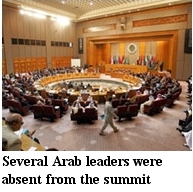 |
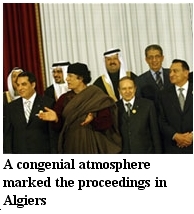 |
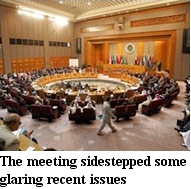 |
The headline and caption to the photograph in Report 2 do the same work as
in Report 1. The Arab League issued a communique reaffirming their
commitment to the initiative of 2002. The communique outlined the basic
requirements of their position. That is what you learn from the headline.
From the photograph and the caption you can infer that the leaders
decided not to raise the matters on which they differed. Hence, a congenial
photo op and a caption pointing out the congeniality. The text of the report
indicates that it could have been otherwise. "The summit managed to avert
differences over prickly issues . . ."
The third report is about Israel's rejection of the Arab call for action. The
headline is followed by three substantial paragraphs outlining Israel's
rejection. That is followed by a recapitulation of the Arab proposal. But the
photograph and the caption carry the story back to the Arab League's
deliberations. They are again sitting in a circle producing a communique that
they knew will be rejected. It is easier to reaffirm the 2002 initiative than
to tackle the 2005 differences over how best to proceed.
BBC tells a story in prospect. The headline for the report is: "Arab summit
to renew Israel offer." They are writing as the meeting begins, so this is
BBC's informed speculation about what will happen. The prospective character
of the news report is reinforced by the photograph and caption. "Libya's
leader was first to arrive . . ." The accompanying photograph is Libya's
leader, Muammar Khaddafi, being greeted by his host, Abdelaziz
Bouteflika, the president of Algeria. This is a picture of a meeting that is
only beginning.
The report covers many of the points covered in the three Aljazeera
reports. The Jordan proposal that is being rejected, the attendance of only
13 of 22 heads of state, a review of the 2002 initiative and attribution to
Saudi Arabia. In addition, the story reports on the agenda for the meeting,
and reports on a point that is not covered by Aljazeera. On the first day
Algerian President Bouteflika "called for the UN to issue a definition of
terrorism." He called for a definition of terrorism that that could be the
basis for "an alliance between civilizations."
Finally there is a CNN web page from March 23 about the closing of the
conference. It is the briefest of the reports, but it covers the
major points about the meeting: rejection of Jordan's proposal,
reaffirmation of the 2002 peace plan, and a point not mentioned by
Aljazeera or BBC. "Arabs 'to better market peace plan'" was the headline. CNN
means business, and marketing is
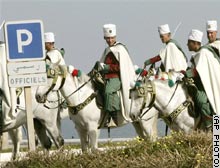 the
metaphor that frames the action. CNN reports that Arab leaders conclude
the meeting with a plan to set up a committee that will "explain their plan to
Europe, the United States and other nations." However, they are unable to
agree on the membership of the committee. The photograph accompanying the
report, a picture of the Algerian horse guard, provides what northern CNN
editors presume is a bit of oriental local color.
the
metaphor that frames the action. CNN reports that Arab leaders conclude
the meeting with a plan to set up a committee that will "explain their plan to
Europe, the United States and other nations." However, they are unable to
agree on the membership of the committee. The photograph accompanying the
report, a picture of the Algerian horse guard, provides what northern CNN
editors presume is a bit of oriental local color.
The overall story gets generally similar coverage by the different websites.
The central themes of the coverage are the rejection of the plan proposed
by Jordan and the reaffirmation of the 2002 initiative. There
are, however, some differences in texture and details.
Aljazeera, appropriately for its regional location, covers the conference
more fully than BBC and CNN with a before, during, and after report. BBC,
consistent with Britain's colonial history in the Arab world, has a
rather long story about what the conference will probably do. And CNN has the
briefest and most business-like coverage.
Health Stories
Following our discussion of the different networks' treatment of a specific
initiative in the Middle East conflict, we turn to sample news stories from
each of the networks about health issues.
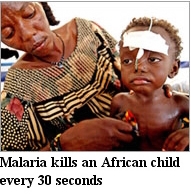 |
The Aljazeera story leads with a picture of victims of malaria, African
victims. The caption says that "malaria kills an African child every 30
seconds." The headline focuses on the disease: "New boost to malaria
research." The lead paragraph again focuses on malaria. Only next do we read
about a new large grant from the Bill and Melinda Gates Foundation. The text
that follows again focuses on malaria. At the bottom, there is a wider
north-south theme. "If those children were in rich countries," Bill Gates is
quoted as saying, "we would have headlines, we would take action. We wouldn't
rest until every child was protected." The story itself is framed by columns
of links to other stories. There are five links to other stories about
malaria, but the rest are only distantly related or completely unconnected to
malaria.
The BBC presentation starts with the same technology and the same story, but
the framing and interpretation are different. In tune with the BBC's greater
attention to health issues, the flanking columns, particularly the one on the
right, provide more supplementary links to information about malaria and
health issues. The leads are a bit more action oriented. The
headline highlights an actor and an action, rather than the victims. "Gates
gives 28m to malaria team." There is a threatening picture of the mosquito
enemy. The article tells the story of Bill and Melinda Gates helping the
effort to conquer this debilitating disease and lead all the world's people to
a more healthy future.
We found no parallel CNN story at this time. There were, however, earlier
treatments in May and June. The first story starts in the global north,
highlighting the Gates Foundation but moves quickly to the
Zambia in the global south, victims of malaria, and contributions to
prevention and treatment. Interestingly there is almost a full column ad, no
picture, and no focused array of related web links.
The second CNN story begins with the headline "Gates targets global health
crisis," and there is a graphic picture of a malaria
victim. In this story, however, advertising and web clutter have
advanced, eating the news hole, which now gets only about one third of the
available space on the page.
All three networks cover malaria with similar formats and themes. Again, there
are important differences. Aljazeera focuses more on southern victims. The
northern networks, BBC and CNN, pay more attention to northern donors like
Bill and Melinda Gates. But, BBC moves southward in providing more links to
other health stories. CNN doesn't get carried away with alien insects,
suffering victims, or charitable heroics in the news hole; it maximizes
advertising.
Globalizing Media, North-South Issues, and Global Action
Globalizing media ride the wave of emerging communication technology. Our
study has focused rather narrowly on three networks that aspire to a global
audience--Aljazeera, BBC, and CNN. We have sought to investigate the way they
approach global north-south issues by focusing very specifically on the
frequency of the keyword "initiative" on their websites and its surrounding
textual context.
Our research suggests that globalizing journalists are not drawn to
"north-south" as an independent topic. We found no use of "north-south" at
all. Given this fact, we substituted "initiative" as the object of our
attention and got better results. Even here, however, the findings were mixed.
Initiative appeared rarely in the headlines; most often it was embedded
further down in the text of the story. It did not appear in quotes from the
leading political actors but rather in journalistic summaries of their
actions.
"Initiative" appears to be a journalistic term of art, describing a plan,
policy, proposal, or project. More than those terms, however, "initiative"
frames global events in the language of action. Although it has too many
syllables and is too abstract to pack much punch, "initiative" still implies
agency and free will, the possibility of change and new beginnings. Above all
it suggests newness, and that is, after all, the domain of news.
We found that the different networks reported initiatives in ways that
reflected common technology and professional norms, on the one hand, and
their diverse cultures on the other. As we had expected, the web page format
itself structured what they could say and how they said it. At the same time,
each network started from a different historical and geographical place,
which influenced content. American, Arab, and British professional and
popular cultures helped frame the news of the day to some extent, even in
networks that aspired to a broader global audience.
While north-south terms are explicitly missing, north-south
perspectives appear implicitly in the reporting of different
initiatives. The cultures of the media elites and their target
audiences give particular flavors to each network and help to
differentiate its personality from competitors. The technology
and professional norms of the globalizing media are largely a creation of
northern actors. They have had an important influence in establishing a
common platform, a space in which political and media elites create the
news. This space has been, at least till now, largely a northern space,
reflecting northern professional "best practices" and appealing to northern
audiences. Further, Aljzeera's production of an English language website uses
not only a northern language but also points to an audience using that
language.
Southern actors have largely had to try and fit themselves in. At the same
time, the emergence of globalizing media with southern roots, such as
Aljazeera, has allowed southern media actors to speak in a somewhat
different voice. To survive in the common communication ecosystem, they must
also differentiate themselves and create their own niches. Northern
dominated common technology and norms have driven the convergence of
globalizing news media and the integration of international communication. At
the same time, northern and southern identities and interests, ideologies
and interpretations now interact in the mixed, hybrid space that is the
emerging international communication order.
References
Artz, Lee and Yahya Kamilipour. 2006.
The Media Globe: Trends in Interntional
Mass Media. Lanham MD: Rowman and Littlefield.
Beer, Francis A. and G. R. Boynton. 2004. "Globalizing Political Action:
Building bin Laden and Getting Ready for 9/11", The American Communication
Journal 7 (2004).
http://www.acjournal.org/holdings/vol7/index.htm
Beer, Francis A. and G. R. Boynton. 2003. "Globalizing Terror", POROI
Journal 2, 1
http://inpress.lib.uiowa.edu/poroi/papers/beer030725_outline.html
Slater,
David. 2004. Geopolitics and the Post-Colonial: Rethinking North-South
Relations. London: Blackwell.
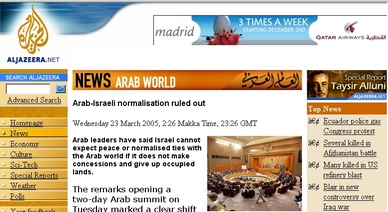
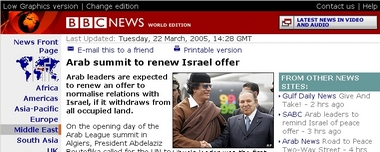
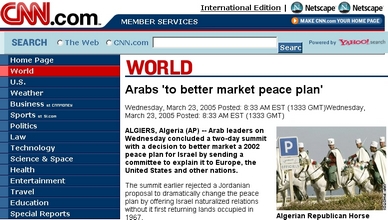



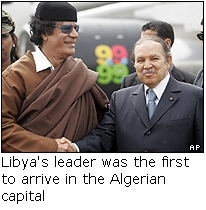
 the
metaphor that frames the action. CNN reports that Arab leaders conclude
the meeting with a plan to set up a committee that will "explain their plan to
Europe, the United States and other nations." However, they are unable to
agree on the membership of the committee. The photograph accompanying the
report, a picture of the Algerian horse guard, provides what northern CNN
editors presume is a bit of oriental local color.
the
metaphor that frames the action. CNN reports that Arab leaders conclude
the meeting with a plan to set up a committee that will "explain their plan to
Europe, the United States and other nations." However, they are unable to
agree on the membership of the committee. The photograph accompanying the
report, a picture of the Algerian horse guard, provides what northern CNN
editors presume is a bit of oriental local color.
